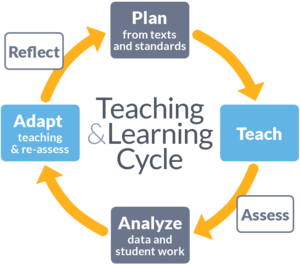
Overview
Engage in responsive cycles of teaching and learning with your students that are rooted in them demonstrating their thinking and learning in a variety of ways. Use classroom assessment systems and routines to gather information on student progress toward learning goals and to respond through feedback and instructional adaptations to ensure that all students demonstrate proficiency on grade-level standards and skills.
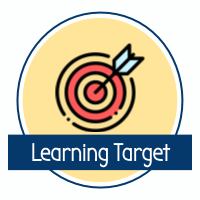
Plan & Teach
Start by setting learning targets to make success criteria for student work clear at the outset. Students should have a variety of opportunities and modalities to show what they know that are built right into curriculum and instruction through formative assessment.
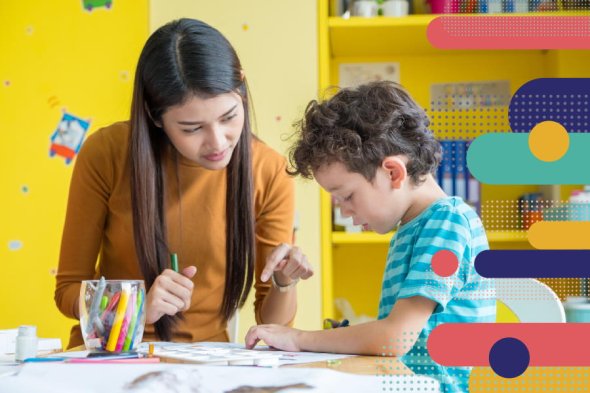
Analyze & Adapt
Analyze student work from these formative assessments, and provide students with feedback that allows them to reflect on their learning, resolve misconceptions and make new connections. When this feedback and opportunity for revision is paired with adapting curriculum and instruction to meet identified student needs, students are able to demonstrate proficiency on summative assessments.
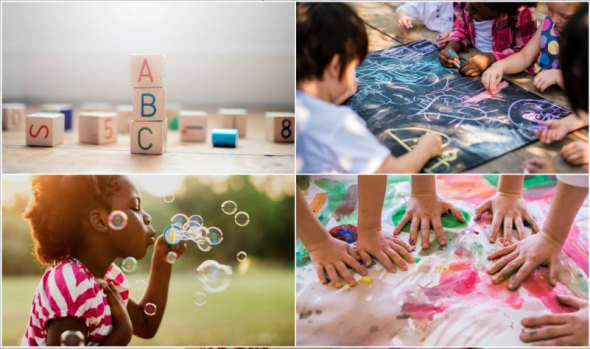
Engaging in responsive teaching and learning cycles produces bodies of evidence students and teachers can use to make informed decisions about how to move student learning forward and create more inclusive classrooms and schools. When assessment is viewed more broadly with varied and authentic opportunities to express learning, students can demonstrate their learning in culturally responsive ways.
Identifying Learning Targets
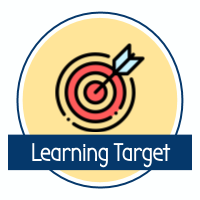
The process of learning shouldn’t be a mystery. Learning targets provide students with tangible goals that they can understand and work toward. Rather than the teacher taking on all of the responsibility for meeting a lesson’s objective, learning targets, written in student-friendly language and frequently reflected on, transfer ownership for meeting objectives from the teacher to the student. (See examples below from pg. 27 Leaders of Their Own Learning)
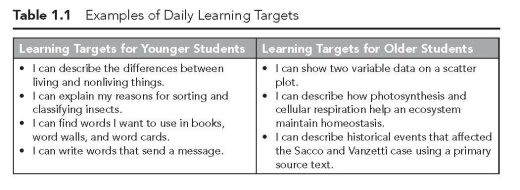
- Use explanations of content that are clear, coherent, and support student understanding of content.
- Differentiate instruction as needed in response to student learning needs, including enrichment and extra support.
- Provide choices for how students engage in the content, including digital learning and multimedia options.
- Convey or provide accurate content (and all content necessary) for students to achieve the learning goal(s).
Check out an example of using a learning target throughout a lesson in a kindergarten class:
Resources and Examples:
Formative Assessment

Formative assessment is a process teachers and students use during instruction that provides feedback to adjust ongoing teaching moves and learning tactics. It is not a specific test, event, or bank of test items. When effectively implemented formative assessment as a process assists students in achieving intended instructional outcomes. Key practices include:
- Clear lesson-learning goals and success criteria, so students understand what they’re aiming for;
- Evidence of learning gathered during lessons to determine where students are relative to goals;
- A pedagogical response to evidence, including descriptive feedback that supports learning by helping students answer: Where am I going? Where am I now? What are my next steps?;
- Peer- and self-assessment to strengthen students’ learning, efficacy, confidence, and autonomy; and
- A collaborative classroom culture where students and teachers are partners in learning.
All students demonstrate how well they understand lesson content and their progress toward learning goals through their work and/or responses.
Check out some examples of formative assessment in practice in this 6th Grade Language Arts class:
---
- Questions, tasks, or assessments yield data that allow students and the teacher to assess students’ progress toward learning goals, help pinpoint where understanding breaks down, and what strengths can be built upon. Digital tools can help teachers gather and organize student data.
Resources and Examples:
Analyzing Student Work Samples
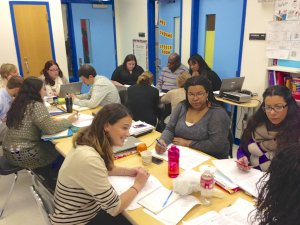
Engaging in a collaborative process of analyzing student work allows a group of educators to analyze the learning experiences they have designed for their students and determine their effectiveness. When teachers collaboratively analyze student work they can build understanding and agreement about the consistent use and interpretation of a rubric with the goal of improving student learning. Student work could include writing, drawing, audio, videos, projects. This process encourages teachers to consider:
- What are my students’ strengths with regard to the required knowledge and skills?
- What are my students’ learning needs with regard to the required knowledge and skills?
- Do students have sufficient foundational content and process skills to approach new learning?
- How can I support student learning through scaffolding and differentiation?
The most important benefit of analyzing student work is improved student learning. Student responses, work and interactions demonstrate that all or almost all students are on track to achieve stated or implied grade-level and/or IEP aligned learning goals.
Check out an example of analyzing student work samples using peer feedback:
Here is one example of a protocol you might use to support collaborative analysis of student work.
Feedback & Revision
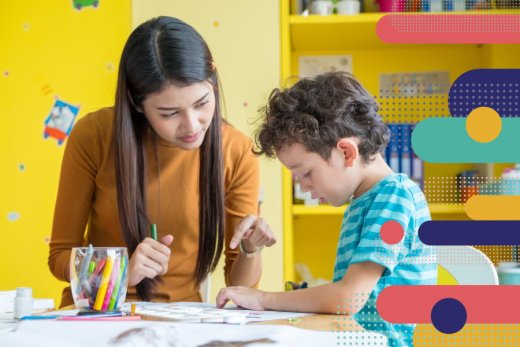
Providing students with meaningful feedback and opportunities to revise their work can greatly enhance their learning and achievement. When people are trying to learn new skills, they must get some information that tells them whether or not they are doing the right thing. Learning in the classroom is no exception. Both the mastery of content and, more importantly, the mastery of how to think require trial-and-error learning. Here are five research-based tips for providing students with the kind of feedback that will increase motivation, build on existing knowledge, and help them reflect on what they’ve learned.
- Be as specific as possible: Feedback like “Great job!” doesn’t tell the learner what they did right. Take the time to provide learners with information on what exactly they did well, and what may still need improvement. It may also be helpful to tell the learner what they are doing differently than before.
- The sooner the better: Feedback is most effective when it is given immediately. Of course, it’s not always possible to provide students with feedback right on the spot, but sooner is definitely better than later. Digitally capturing work on Seesaw or Google Classroom can facilitate quick cycles of feedback.
- Address the learner's advancement toward a goal: Effective feedback is most often oriented around a specific achievement that students are (or should be) working toward. When giving feedback, it should be clear to students how the information they are receiving will help them progress toward their final goal.
- Present feedback carefully: The way feedback is presented can have an impact on how it is received, which means that sometimes even the most well-meaning feedback can come across the wrong way and reduce a learner’s motivation. When learners feel too strictly monitored, when learners interpret feedback as an attempt to control them, or when learners feel an uncomfortable sense of competition (like when individual feedback is shared publicly) feedback could be counterproductive. To avoid these situations, fully explain the purpose of any monitoring, and ensure that learners understand how the feedback is meant to support their own growth.
- Involve learners in the process: The importance of involving learners in the process of collecting and analyzing performance-based data cannot be understated. When students engage in this process alongside you, they develop an awareness of their learning, are more easily able to recognize strengths and gaps in skills or understanding, and eventually develop strategies for tackling weak points themselves. Students can capture their work digitally and later review and reflect on their work samples. Students can practice using feedback protocols for peer feedback in oral, written or digital formats.
Check out an example of peer feedback and revision:
Resources and Examples:
- T.A.G. Feedback: Sentence starters #1 / Sentence starters #2 (English / Spanish / Chinese)
- Two Stars and a Wish (English / Spanish)
- Feedback and Assessment with Seesaw
- Refection Activities on Seesaw
Summative Assessment
Summative assessments evaluate student learning, knowledge, proficiency, or success at the conclusion of an instructional period, like a unit, course, or project. Tests, exams, final essays, and reports represent more traditional summative assessments. Summative assessments are almost always formally evaluated (though they do not need to be). Summative assessment can be used to great effect in conjunction and in alignment with formative assessment. Because summative assessments are usually higher-stakes than formative assessments, it is especially important to ensure that the assessment aligns with the goals and expected outcomes of the instruction and that students have extensive opportunities to express their learning through academic writing and/or explanations using academic language.
Portfolios and Performance Tasks are two examples of possible summative assessments
Portfolios can be created on paper or in Seesaw to include multimedia elements.
Presentations and Exhibitions of Learning are two more examples of possible summative assessment
Resources and Examples:
This page was last updated on June 15, 2023

